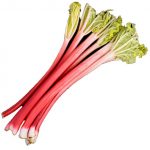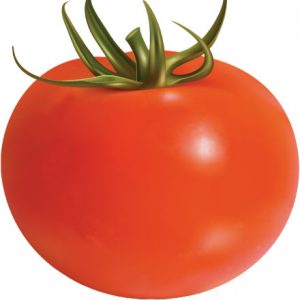Growing vegetables
Robin Gale-Baker, from Sustainable Macleod, discusses growing various vegetables. This is one of a series of articles she has written about growing various veggies (see right hand sidebar). She has also written a number of articles about growing various herbs, growing various fruit trees and general growing techniques.
Crowns
 Some fruit and vegetables are grown from crowns and these require careful planting. A crown is defined as a part of a plant where stem and roots meet. Examples are rhubarb, strawberries, asparagus and horseradish.
Some fruit and vegetables are grown from crowns and these require careful planting. A crown is defined as a part of a plant where stem and roots meet. Examples are rhubarb, strawberries, asparagus and horseradish.
For rhubarb and strawberries, it is important that the eye or bud of the crown is planted at, or just above, soil level as this prevents crown rot. Each is best grown in a dedicated bed in sunny, moist, well-drained conditions and both do well with a generous mix of well-rotted manure and compost.  Rhubarb should be divided after a number of years when it is clear that its production is waning. Use a sharp spade to cut through the crown making sure that each piece has an eye, and re-plant. Strawberries are grown from runners which develop from the original plant. Cut the stem between the original plant and the new plant, trim the runner of dead leaves and the runner stem, and re-plant. Both will produce in the season in which they are planted.
Rhubarb should be divided after a number of years when it is clear that its production is waning. Use a sharp spade to cut through the crown making sure that each piece has an eye, and re-plant. Strawberries are grown from runners which develop from the original plant. Cut the stem between the original plant and the new plant, trim the runner of dead leaves and the runner stem, and re-plant. Both will produce in the season in which they are planted.
 Unlike rhubarb and strawberries, asparagus needs to be planted deep in trenches and backfilled as the shoots emerge. The first spears should not be cut until the following season and then only 2-3 per plant. The season after that as many spears as you like can be harvested. Horseradish, on the other hand, needs little attention. It is grown from root cuttings – either small pieces of root that can be buried, or crowns. Plant the crowns so that the shoots are just above ground, and leave for a couple of years before harvesting, and remember that it is quite invasive!
Unlike rhubarb and strawberries, asparagus needs to be planted deep in trenches and backfilled as the shoots emerge. The first spears should not be cut until the following season and then only 2-3 per plant. The season after that as many spears as you like can be harvested. Horseradish, on the other hand, needs little attention. It is grown from root cuttings – either small pieces of root that can be buried, or crowns. Plant the crowns so that the shoots are just above ground, and leave for a couple of years before harvesting, and remember that it is quite invasive!
Early heritage tomatoes
 At this time of year – late July/early August – Bunnings sell a small range of heritage tomatoes from Diggers. You will find them in the indoor nursery section and this is for a very good reason: it is far too early to plant them out. However, if you have a greenhouse, or perhaps a sunny verandah, planting these early tomatoes in large pots of compost will give you advanced plants for putting in your garden in October, or even September if the weather is good and frosts unlikely. One advantage of doing this is that, as the plant grows, laterals will develop. Laterals are the shoots that grow between the main stem and a side branch. Normally they are pinched out to strengthen the plant. However, leave them until they are around 6cm long, pinch them out, plant them in potting mix and water well. Water each day and, within a week or two, you will have new plants with strong roots to plant out for no extra cost. A second advantage is that you could have tomatoes by Cup Day in early November! Traditionally, Cup Day has been the day that Melbournians are advised to plant out their tomatoes so you could be harvesting whilst your neighbours are only just planting!
At this time of year – late July/early August – Bunnings sell a small range of heritage tomatoes from Diggers. You will find them in the indoor nursery section and this is for a very good reason: it is far too early to plant them out. However, if you have a greenhouse, or perhaps a sunny verandah, planting these early tomatoes in large pots of compost will give you advanced plants for putting in your garden in October, or even September if the weather is good and frosts unlikely. One advantage of doing this is that, as the plant grows, laterals will develop. Laterals are the shoots that grow between the main stem and a side branch. Normally they are pinched out to strengthen the plant. However, leave them until they are around 6cm long, pinch them out, plant them in potting mix and water well. Water each day and, within a week or two, you will have new plants with strong roots to plant out for no extra cost. A second advantage is that you could have tomatoes by Cup Day in early November! Traditionally, Cup Day has been the day that Melbournians are advised to plant out their tomatoes so you could be harvesting whilst your neighbours are only just planting!
Planting asparagus
 Asparagus is a perennial vegetable lasting, 30 years so it provides excellent value. July is when asparagus crowns are commercially available from nurseries. Asparagus bed preparation is time consuming so June is a great month to prepare a new bed, ready for planting in July.
Asparagus is a perennial vegetable lasting, 30 years so it provides excellent value. July is when asparagus crowns are commercially available from nurseries. Asparagus bed preparation is time consuming so June is a great month to prepare a new bed, ready for planting in July.
Asparagus can be planted either in the ground or in a high-sided raised bed. Either way, trenches need to be dug to a depth of 30cm below the soil surface, 30cm wide, and with 30cm between trenches. At the bottom of each trench, make a small hill of soil down its length. This is to fan out and drape the roots over. Snip off any damaged or broken roots before planting (they will grow back quickly). Place the crowns around 30cm apart. Cover the crowns so that there is several centimetres of soil above them with no roots visible. Combine the soil with a mix of well rotted manure and compost (asparagus are heavy feeders).
As the crown shoots, keep covering the shoots in the same way until you reach the surface. This will take 3-4 months.
In the first year, do not cut any spears; in the second, cut 2-3 per crown; and in the third, cut as many as you like. Water well both during the establishment phase and thereafter. Asparagus does not like competition from weeds or other plants so mulch and weed regularly.
[Editor’s note: asparagus is dioecious (separate male/female plants). From an eating perspective, at least anecdotally, one would like all male plants, as their spears tend to be both fatter and more numerous. Over time, this can be achieved by replacing the females. During Autumn, you can tell which is which because only the females have berries.]
When to pick pumpkins and how to ‘cure’ them
 Pick pumpkins when the stem coming out of the top of the pumpkin has withered. Leave 10-12 cm of stem but don’t use it as a handle. You can also ‘knock’ on the pumpkin and if it sounds hollow then it is ready for picking. A pumpkin will not be ready to eat immediately after being harvested. Rather, it needs to be ‘cured’ (aka ‘hardened off’) and allowed to sweeten. To do this, rest the pumpkin on some mesh or wire so that air can circulate around it, with newspaper or straw underneath so that the skin doesn’t tear or blemish. Leave it in the sun for 2-3 weeks then turn it over and do the same for the bottom. Then the pumpkin will be ready to eat.
Pick pumpkins when the stem coming out of the top of the pumpkin has withered. Leave 10-12 cm of stem but don’t use it as a handle. You can also ‘knock’ on the pumpkin and if it sounds hollow then it is ready for picking. A pumpkin will not be ready to eat immediately after being harvested. Rather, it needs to be ‘cured’ (aka ‘hardened off’) and allowed to sweeten. To do this, rest the pumpkin on some mesh or wire so that air can circulate around it, with newspaper or straw underneath so that the skin doesn’t tear or blemish. Leave it in the sun for 2-3 weeks then turn it over and do the same for the bottom. Then the pumpkin will be ready to eat.
Why are my tomatoes still green?
 There’s been a fair bit of consternation this season (2019/20)about when, or even if, tomatoes are going to ripen. The good news is that they probably will. The bad news is that it is not clear when.
There’s been a fair bit of consternation this season (2019/20)about when, or even if, tomatoes are going to ripen. The good news is that they probably will. The bad news is that it is not clear when.
Like all vegetables, the movement from seed to fruit in tomatoes is complex, involving many simultaneous processes. When plants are faced with weather extremes, some of these processes can be thrown out of balance. There’s an order that needs to happen: seed germinates, seedlings begin producing foliage, roots expand, flowers form, fruit forms, plant produces chemicals for colour, texture and flavour, and fruit ripens.
In ‘normal’ conditions, a tomato plant allots enough energy to each requirement to produce full size fruit in around 25 days and the first ripe fruit in around 50 days. However, we no longer have such conditions and the plants have to deal with numerous and sudden changes in air temperature. They also have to deal with the same beneath the surface, where constant changes in soil temperature disrupt the normal growth pattern.
Whether your tomatoes are ripening now may depend on when you happened to plant them. It seems that tomatoes planted in October are ripening more readily than those planted in November and later, even though there has been enough time for all to ripen in normal conditions. This may reflect less extreme weather earlier in the season. But if you are getting ripe tomatoes now, you may notice tough skins caused by high temperatures and inadequate water during December.
Rather than try to force your tomatoes to ripen, be patient. Don’t add fertiliser as this will cause the plant to put energy into growing foliage and roots rather than producing compounds for colour, texture and flavour. Mulch the roots and water regularly to attempt to keep the soil temperature below 26.5 degrees celsius. Shade on only the hottest days, and then remove the shade once the temperature drops, so as to not further slow the ripening process.
